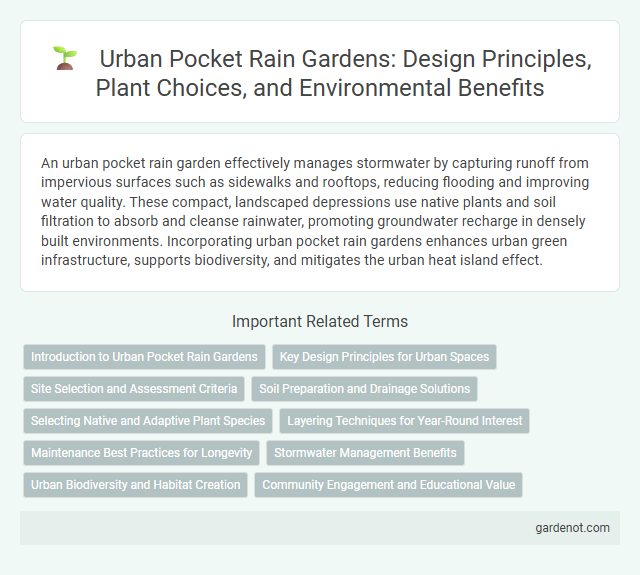An urban pocket rain garden effectively manages stormwater by capturing runoff from impervious surfaces such as sidewalks and rooftops, reducing flooding and improving water quality. These compact, landscaped depressions use native plants and soil filtration to absorb and cleanse rainwater, promoting groundwater recharge in densely built environments. Incorporating urban pocket rain gardens enhances urban green infrastructure, supports biodiversity, and mitigates the urban heat island effect.
Introduction to Urban Pocket Rain Gardens
Urban pocket rain gardens are small, strategically placed green spaces designed to manage stormwater runoff in densely built environments. These gardens filter pollutants, reduce flooding, and improve urban biodiversity by incorporating native plants and permeable soil. Compact yet highly effective, they transform underutilized urban areas into sustainable water management solutions.
Key Design Principles for Urban Spaces
Urban pocket rain gardens maximize stormwater management by incorporating permeable surfaces and native plant species that enhance water infiltration and biodiversity. Space-efficient design prioritizes compact layout and vertical planting to optimize limited urban areas while reducing runoff and heat island effects. Integrating these elements supports sustainable urban ecosystems and improves water quality in dense city environments.
Site Selection and Assessment Criteria
Urban pocket rain gardens require strategic site selection based on factors such as soil permeability, drainage patterns, and sun exposure to ensure effective water absorption and plant growth. Assessment criteria include evaluating slope gradient to prevent erosion, proximity to impervious surfaces for runoff capture, and potential impact on nearby structures and utilities. Proper site assessment enhances stormwater management, reduces urban flooding, and supports local biodiversity.
Soil Preparation and Drainage Solutions
Urban pocket rain gardens require well-prepared soil with a mix of sandy loam, compost, and organic matter to enhance permeability and nutrient retention. Effective drainage solutions include installing underdrains or gravel layers to prevent waterlogging while promoting infiltration and reducing runoff. Proper soil grading and amendment ensure optimal water absorption, supporting plant health and urban stormwater management.
Selecting Native and Adaptive Plant Species
Selecting native and adaptive plant species for urban pocket rain gardens enhances stormwater management by improving infiltration and pollutant removal. Native plants like blue flag iris and swamp milkweed are well-suited to local soil and climate conditions, promoting resilience and reducing maintenance needs. Adaptive species that tolerate periodic flooding and drought ensure sustainable garden performance throughout seasonal changes.
Layering Techniques for Year-Round Interest
Urban pocket rain gardens utilize strategic layering techniques by incorporating a mix of native perennials, shrubs, and groundcovers to ensure vibrant and sustainable year-round interest. Seasonal plant diversity maximizes water absorption and supports urban biodiversity while providing continuous visual appeal through varied textures and colors. Incorporating deep-rooted plants enhances soil filtration and reduces runoff, optimizing the garden's ecological function in compact urban spaces.
Maintenance Best Practices for Longevity
Urban pocket rain garden maintenance involves regular removal of debris and invasive weeds to ensure efficient water infiltration and healthy plant growth. Periodic inspection of inflow and outflow points prevents clogging and erosion, preserving the garden's structural integrity. Applying mulch helps retain soil moisture and suppress weeds, extending the garden's longevity in urban environments.
Stormwater Management Benefits
Urban pocket rain gardens effectively reduce stormwater runoff by capturing and infiltrating precipitation on-site, decreasing the volume and velocity of water entering municipal drainage systems. These small-scale green infrastructures improve water quality by filtering pollutants such as sediments, heavy metals, and nutrients before water reaches natural water bodies. Implementing urban pocket rain gardens enhances flood mitigation in densely populated areas while promoting groundwater recharge and supporting urban biodiversity.
Urban Biodiversity and Habitat Creation
Urban pocket rain gardens serve as vital green infrastructure by enhancing urban biodiversity and creating microhabitats for native flora and fauna. These small-scale rain gardens improve stormwater management while providing essential refuge for pollinators, birds, and beneficial insects in densely built environments. Integrating diverse plant species tailored to local ecosystems promotes resilience and supports ecological connectivity within urban landscapes.
Community Engagement and Educational Value
Urban pocket rain gardens serve as vital green infrastructure that enhances stormwater management while promoting community engagement through hands-on maintenance and local stewardship programs. These small-scale rain gardens act as outdoor classrooms, offering residents and students practical education on water conservation, native plant species, and biodiversity. By fostering environmental awareness and collective responsibility, urban pocket rain gardens contribute to resilient and informed neighborhoods.
Urban pocket rain garden Infographic

 gardenot.com
gardenot.com